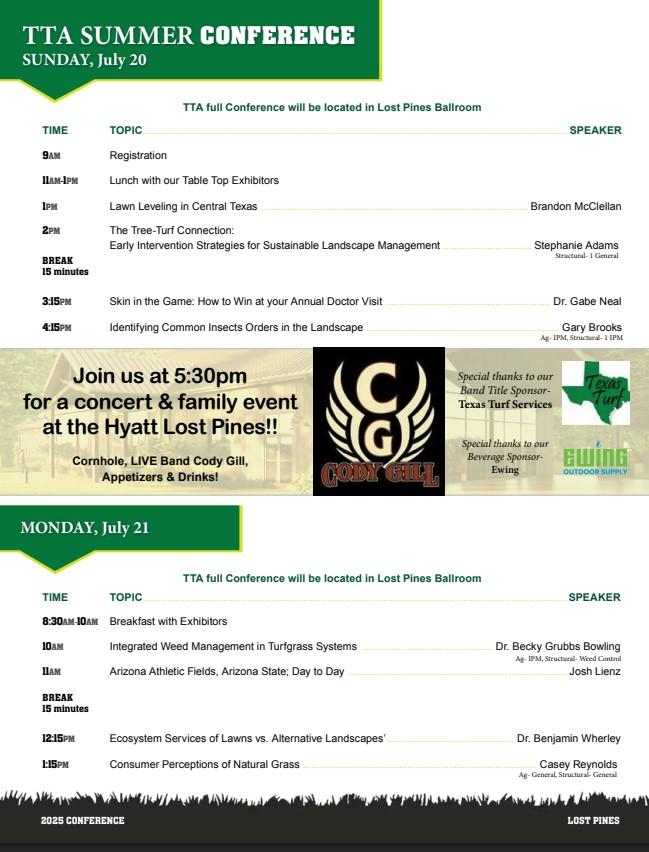
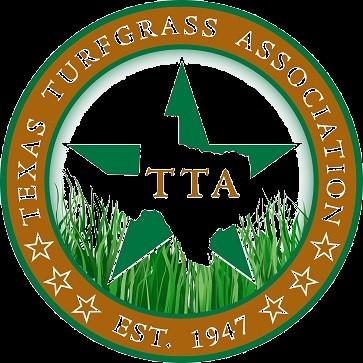
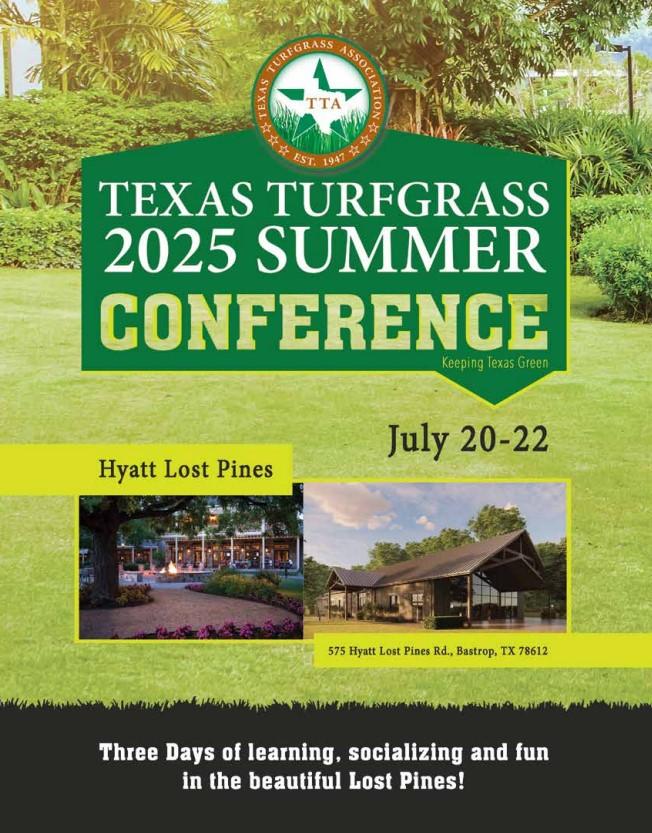

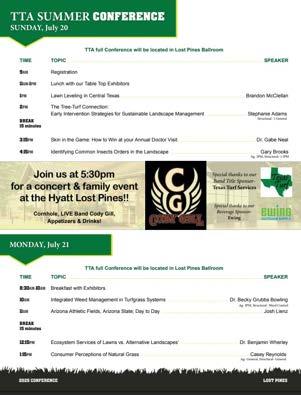
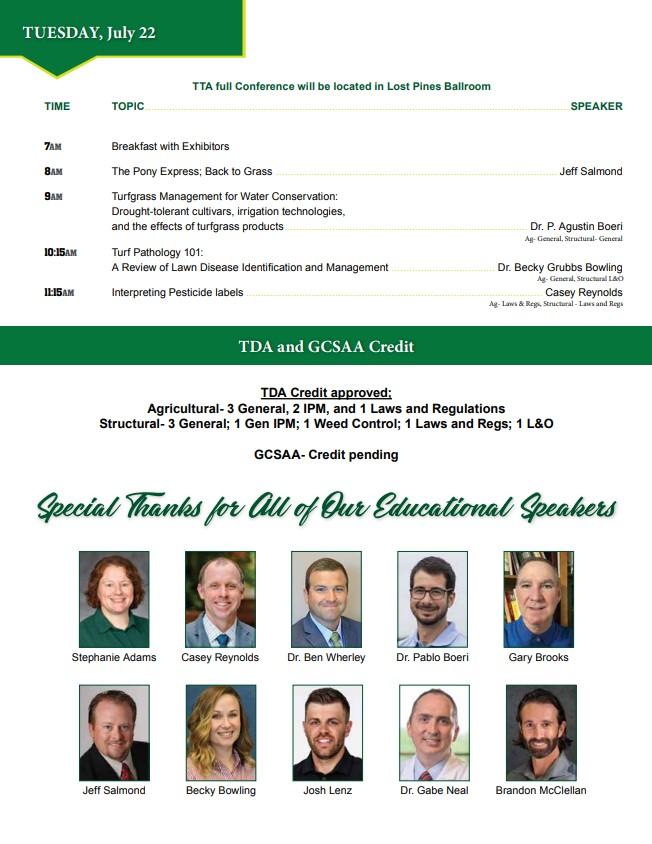










It is my great honor and privilege to welcome you all to this year’s Texas Turfgrass Association 2025 Summer Conference. Whether you’ve traveled across the state or joined us from just down the road, we’re truly grateful to have you here.
As the president of this remarkable organization, I am filled with immense pride our vibrant industry but also in the dedication of our hardworking members and the pivotal role we play in shaping and preserving Texas landscapes. From sports fields and golf courses to parks, campuses, and communities, turfgrass professionals are the backbone of some of the most cherished green spaces across our state.
This event is far more than an annual tradition. It is a unique opportunity for us to come together, exchange knowledge, celebrate achievements, and embrace the challenges and innovations that lie ahead. Our work is ever evolving, and this year continues to bring new opportunities for growth and adaptation. Whether it’s responding to drought conditions, refining sustainability practices, or advancing education and research in turfgrass, our commitment to excellence and stewardship remains unwavering.
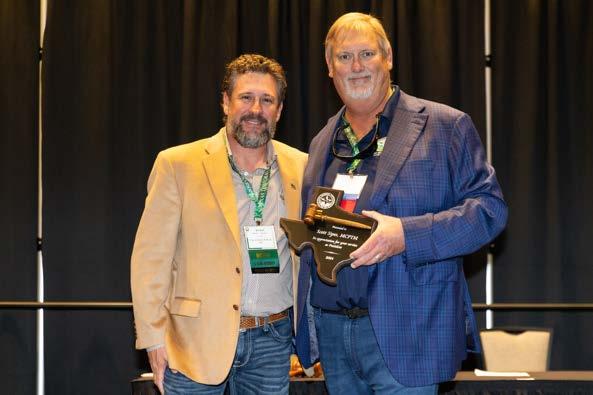
To our vendors, sponsors, and educators—thank you. Your partnership and investment strengthen our industry and propel us toward new heights. To our members whether you are just starting your journey or have dedicated decades to the field, your passion and perseverance are what sustain and drive this organization forward.
Let us make the most of this gathering: connect with one another, ask questions, share ideas, and most importantly, reflect on the significance of what we do. Because behind every blade of grass lies a story a story of care, innovation, and community impact.
Thank you for your presence, your dedication, and your trust in me to serve as your president. I am genuinely excited for what lies ahead and look forward to growing and forging new paths with you season after season.
Welcome, and let’s make this event truly memorable!
Warm regards,
Randall Anderson
2025 Texas Turfgrass Association President

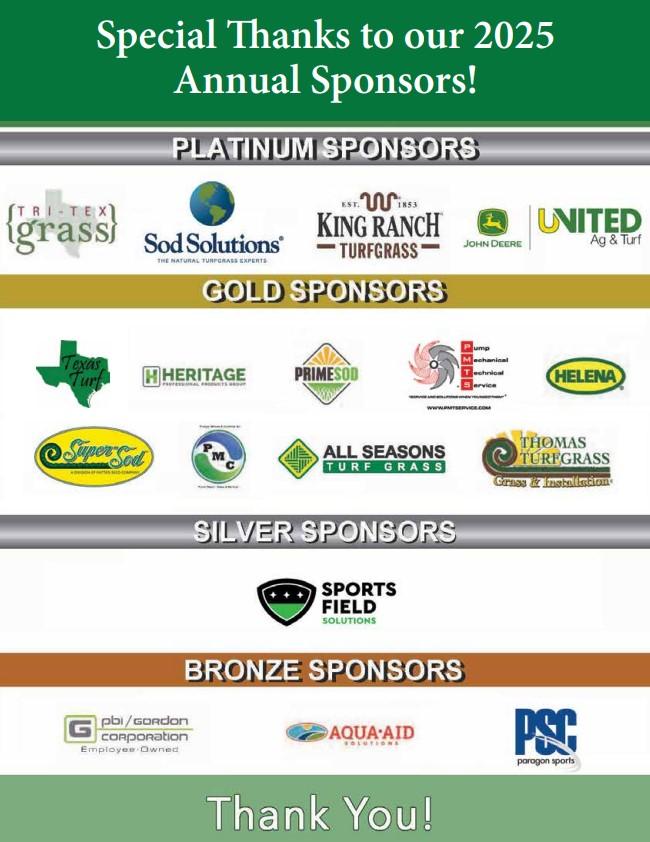
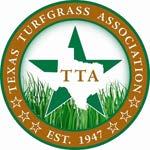
Thank you to all Members and Affiliates for a great start to 2025 and for your continued interest and support!
We hope to see you and your company at our upcoming show, which will be held from July 20 -22, 2025, at the Hyatt Lost Pines in Bastrop, TX. Our association has been growing and evolving, and we are proud to announce the launch of a small yet, exciting merchandise line at the Summer Show. During this event, you will have the exclusive opportunity to get a sneak peek at our new TTA merchandise and even make purchases before anyone else. Your feedback on these products is invaluable to us, and we look forward to hearing your thoughts. Based on your feedback, we plan to continue offering this for our members.


Additionally, we want to ensure that we have your most up-todate contact and employment information. Please email or call me with any updates so we can keep our records current.
Lastly, Membership Certificates have been mailed this month; please be on the lookout and let me know if you do not have them in hand by the end of the month.
Thank you for your continued support and dedication to our association. A special thank you to the TTA Board of Directors and our association sponsors who make this association work.
God Bless,

Katie Flowers Your Executive Director
























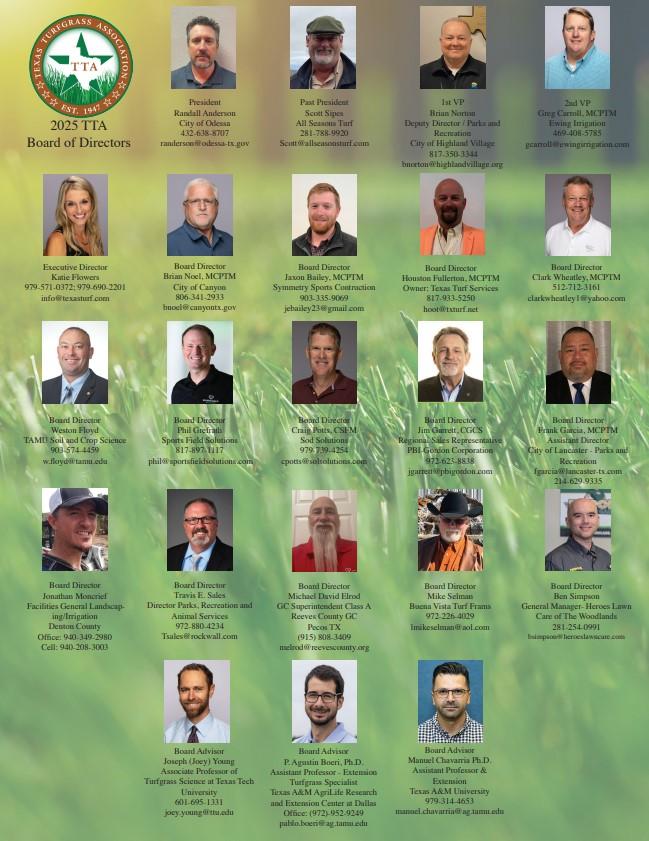
P. Agustin Boeri, Guy Fipps, Ambika Chandra, Charles L. Swanson, Chase Martin, and Mohammed Omer
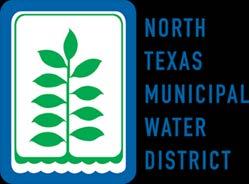
Introduction: Texas is the second highest-populated state in the U.S., reaching ~30 million residents in 2022. With an increase in population comes an increase in water demand. Moreover, climate change, recurrent droughts, and increasing costs of potable water have led to municipal irrigation restrictions, which can pose challenges to turfgrass survival and management. Turfgrasses play a crucial role in urban ecosystems, providing recreational spaces for communities to gather and safe playing surfaces for athletes, enhancing aesthetic appeal and property values, and supporting a wide range of jobs, mitigating urban heat island effects, controlling soil erosion, recharging groundwater, and sequestering carbon.
A wide range of strategies have been implemented for water conservation, including utilizing evapotranspiration (ET) irrigation recommendations and turfgrass cultivars with improved drought resistance. Irrigation recommendations are based on reference evapotranspiration (ETo), representing the water lost from a cool-season grass. In warm-season turfgrass, acceptable turf quality can be maintained at ~60% of Eto or 0.6 crop coefficient (Kc). The Kc of 0.6 is recommended by the American Society of Biological & Agricultural Engineers. The recommendation of 0.6 Eto can be further adjusted by an allowable stress factor (Af).
The WaterMyYard (WMY) program (https://watermyyard.org/ Fipps and Charles Swanson of Texas A&M AgriLife Extension Service as a water conservation effort for homeowners of sponsoring cities and water districts. This program provides user weekly irrigation recommendations obtained from the Texas ET network (https://texaset.tamu.edu/). Currently, WMY adjusts ETo with a Kc of 0.6 for warm-season turfgrasses and an Af of 0.6 (normal stress). During water restrictions, Af is further reduced to 0.5 (high stress).
The primary objective of this project is to examine the Af used for producing WMY watering recommendations. The secondary objective is to evaluate the performance of turfgrass species and cultivars when irrigated under different Af.


https://youtu.be/-HzLyriZkzs? si=_i-52ohr57V7Sglp
Material and Methods: The WMY verification project was established at the Texas A&M AgriLife Research and Extension Center in Dallas, TX, on June 28, 2022. The turfgrass cultivars evaluated were St. Augustinegrass: CobaltⓇ and Raleigh; Zoysiagrass: Palisades; Bermudagrass: Tifway, and TifTufⓇ. The irrigation treatment consisted of 80%, 60%, 50%, and 40% Af (Table 1). The experiment was arranged as a randomized complete block design where each cultivar was replicated four times in one of four irrigation treatments.
Table 1. Reference Evapotranspiration (ETo), total rainfall, and adjusting factors (Af) in 2023 from July 1 to October 21 and 2024 from July 1 to October 21.
The study was designed to simulate common lawn maintenance practices. Plots were mowed at 3.5” once weekly and fertilized with 1 lb N 1000 ft2 of urea, every two months, during the growing season. The mowing height was adequate for St. Augustinegrass, but resulted in a loss of density in bermudagrass, affecting the quality rating of these cultivars.
Plots were irrigated for 30 to 45 minutes 2-3 times a week during establishment (summer 2022). Turf quality ratings (1-9, where 1= dead, 6= minimum acceptable quality, and 9= ideal) were recorded on a weekly basis. Irrigation water requirements were calculated weekly based on the previous 7-day (Monday- Sunday) period.

Reference Evapotranspiration (ETo) was calculated using weather data from the on-site Dallas Agrilife Center weather station (Table 1). Weather data is posted on the TexasET Network website (http://TexasET.tamu.edu).
Low Stress (80% Af): Under low drought stress, Cobalt and TifTuf maintained acceptable turfgrass quality (≥6) throughout the trial period in both 2023 and 2024 (Table 2). Palisades also maintained acceptable quality in 2023; however, quality declined in 2024. In contrast, Tifway and Raleigh dropped below the acceptable threshold by the end of both years.
Table 2. Days of acceptable turfgrass quality (≥6) under different irrigation levels in 2023 and 2024. The quality of the cultivars labeled “Acceptable” did not decline below 6 during the study period. Continued on next page

Moderate stress (60% Af): In 2023, Cobalt and TifTuf maintained acceptable quality for 87 days, one month longer than Palisades, Raleigh, and Tifway (56 days) (Table 2). In the following year, while all the turfgrasses recovered from the drought in 2023, a cumulative drought effect was observed by the end of 2024 in most of the cultivars. The exception was Cobalt, which maintained acceptable quality for 95 days (Table 2). TifTuf and Palisades followed with 65 and 58 days, respectively. Tifway and Raleigh showed more rapid decline, maintaining quality for only 42 and 35 days, respectively.
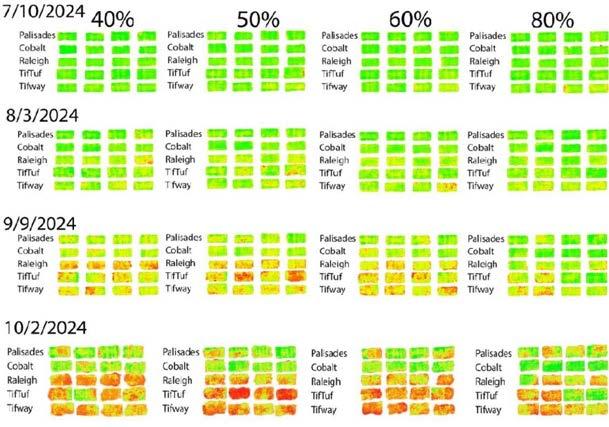
Figure 2. Aerial image of turfgrass plots showing Normalized Difference Vegetation Index (NDVI), a remote sensing technique used to assess the health and density of vegetation. Greener plots show better turfgrass health and higher NDVI values. Red plots show signs of stress.
High stress (50% Af): In the first year, Cobalt maintained acceptable turfgrass quality for 70 days, which was two weeks longer than TifTuf (56 days) and almost four weeks longer than Palisades, Raleigh, and Tifway (43 days) (Table 2). A similar trend to the normal stress level was observed in 2024.
Severe stress (40% Af): In 2023, Cobalt maintained acceptable quality for 56 days, which is three weeks longer than Palisades, Raleigh, and Tifway (34 days) (Table 2). TifTuf remained acceptable for 48 days, about two weeks longer than the other grasses. Similarly, in 2024, Cobalt maintained acceptable quality for 50 days, which is five weeks longer than Raleigh (23 days) (Table 2). In comparison, TifTuf maintained acceptable quality for 45 days, which is 10 days longer than Tifway (35).


Preliminary results demonstrate the superior drought tolerance characteristics of Cobalt St. Augustinegrass and TifTuf bermudagrass. The cultivars maintained acceptable quality under low stress irrigation levels. Moreover, they maintained acceptable quality for longer periods under moderate and higher stress levels. Under native or unrestricted soils, most of the turfgrasses went dormant and recovered from the higher stress levels. Therefore, Af of 50% or 40% could be implemented as a water conservation practice under these conditions. The only exception was Raleigh, which did not recover in Spring 2025 regardless of the irrigation level.
The study was conducted under agricultural clay soils (Vertisol Soil with Austin silty clay type). Corser soils (i.e., higher percentage of sand) or soil in new constructions would increase the irrigation amounts and frequency. Different irrigation levels could be selected based on consumer preferences, soil types, lawn age, drought periods, and unique site conditions such as shade or shallow soils. The study will continue until 2025 to strengthen the results presented in this report.
Acknowledgments: The project was funded by the North Texas Municipal Water District. The sod for the research trial was donated by the members of the Turfgrass Producers of Texas.




